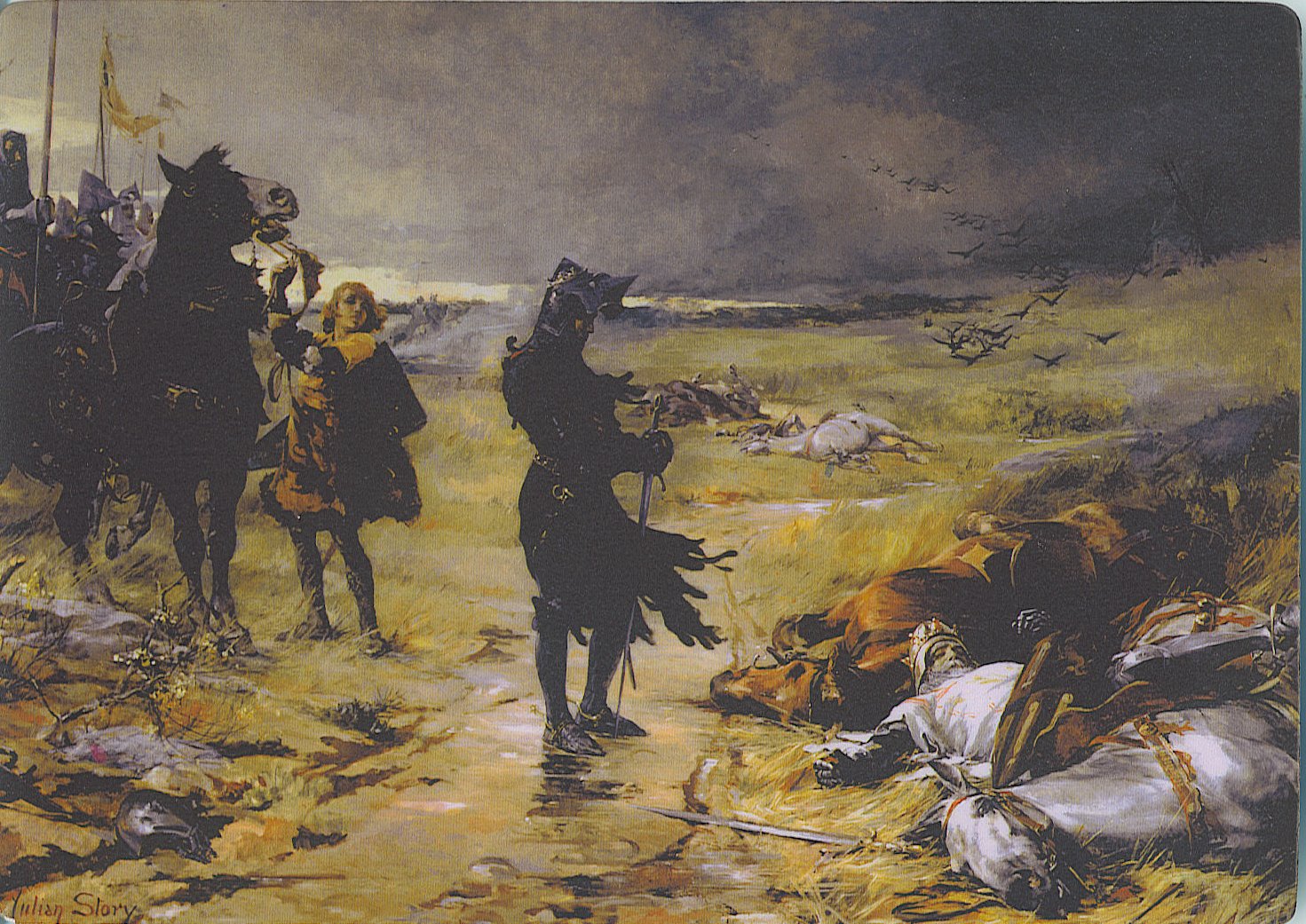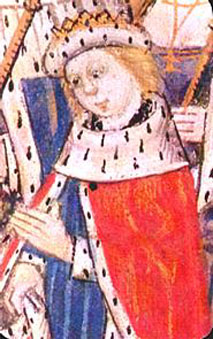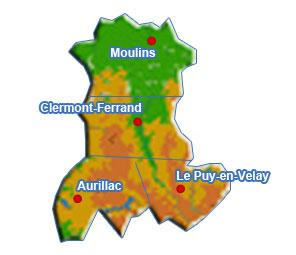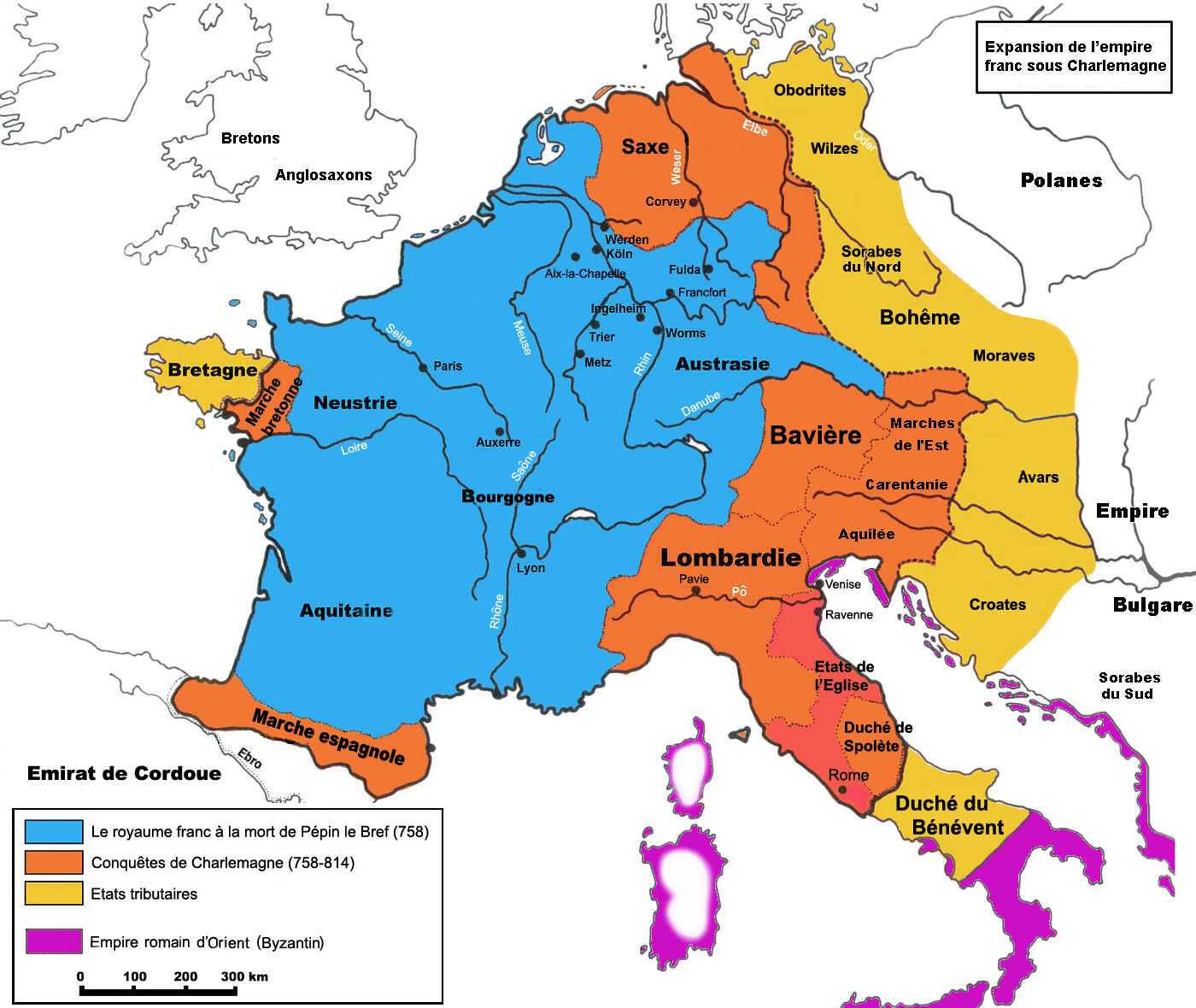|
The Black Prince
Edward of Woodstock (15 June 1330 – 8 June 1376), known as the Black Prince, was the eldest son and heir apparent of King Edward III of England. He died before his father and so his son, Richard II, succeeded to the throne instead. Edward nevertheless earned distinction as one of the most successful English commanders during the Hundred Years' War, being regarded by his English contemporaries as a model of chivalry and one of the greatest knights of his age. Edward was made Duke of Cornwall, the first English dukedom, in 1337. He was guardian of the kingdom in his father's absence in 1338, 1340, and 1342. He was created Prince of Wales in 1343 and knighted by his father at La Hougue in 1346. In 1346, Prince Edward commanded the vanguard at the Battle of Crécy, his father intentionally leaving him to win the battle. He took part in Edward III's 1349 Calais expedition. In 1355, he was appointed the king's lieutenant in Gascony and ordered to lead an army into Aquitaine on ... [...More Info...] [...Related Items...] OR: [Wikipedia] [Google] [Baidu] |
Prince Of Wales
Prince of Wales (, ; ) is a title traditionally given to the male heir apparent to the History of the English monarchy, English, and later, the British throne. The title originated with the Welsh rulers of Kingdom of Gwynedd, Gwynedd who, from the late 12th century, used it (albeit inconsistently) to assert their supremacy over the other Welsh rulers. However, to mark the finalisation of his conquest of Wales, in 1301, Edward I of England invested his son Edward of Caernarfon with the title, thereby beginning the tradition of giving the title to the heir apparent when he was the monarch's son or grandson. The title was later claimed by the leader of a Welsh Revolt, Welsh rebellion, Owain Glyndŵr, from 1400 until 1415. King Charles III created his son William, Prince of Wales, William Prince of Wales on 9 September 2022, the day after his accession to the throne, with formal letters patent issued on 13 February 2023. The title has become a point of controversy in Wales. Welsh ... [...More Info...] [...Related Items...] OR: [Wikipedia] [Google] [Baidu] |
Chivalry
Chivalry, or the chivalric language, is an informal and varying code of conduct that developed in Europe between 1170 and 1220. It is associated with the medieval Christianity, Christian institution of knighthood, with knights being members of various chivalric orders, and with knights' and gentlemen's behaviours which were governed by chivalrous social codes. The ideals of chivalry were popularized in medieval literature, particularly the literary cycles known as the Matter of France, relating to the legendary companions of Charlemagne and his men-at-arms, the paladins, and the Matter of Britain, informed by Geoffrey of Monmouth's , written in the 1130s, which popularized the legend of King Arthur and his knights of the Round Table. The code of chivalry that developed in medieval Europe had its roots in earlier centuries. It arose in the Carolingian Empire from the idealisation of the cavalryman—involving military bravery, individual training, and service to others—especia ... [...More Info...] [...Related Items...] OR: [Wikipedia] [Google] [Baidu] |
Auvergne
Auvergne (; ; or ) is a cultural region in central France. As of 2016 Auvergne is no longer an administrative division of France. It is generally regarded as conterminous with the land area of the historical Province of Auvergne, which was dissolved in 1790, and with the now-defunct administrative region of Auvergne, which existed from 1956 to 2015. The region is home to a chain of volcanoes known collectively as the " chaîne des Puys". The volcanoes began forming about 70,000 years ago, and most have eroded, leaving plugs of hardened magma that form rounded hilltops known as puys. The last confirmed eruption occurred around 4040 BCE. Geography Auvergne is known for its mountain ranges and dormant volcanoes. Together the Monts Dore and the Chaîne des Puys include 80 volcanoes. The Puy de Dôme is the highest volcano in the region, with an altitude of . The Sancy Massif in the Monts Dore is the highest point in Auvergne at . The northern part is covered in hil ... [...More Info...] [...Related Items...] OR: [Wikipedia] [Google] [Baidu] |
Black Prince's Chevauchée Of 1356
The Black Prince's ''chevauchée'' of 1356 was a large-scale Chevauchée, mounted raid by an Anglo-Gascon force under the command of Edward, the Black Prince, between 4 August and 2 October 1356 as a part of the Hundred Years' War. The war had broken out in 1337, but a Truce of Calais, truce and the ravages of the Black Death had restricted the extent of the fighting since 1347. In 1355 the French king, John II of France, John II, determined to resume full-scale war. That autumn, while Edward III of England threatened northern France, his son, Edward of Woodstock, later known as the Black Prince, Black Prince's chevauchée of 1355, carried out a devastating mounted raid, or : an Anglo-Gascon army marched from the English possession of Duchy of Gascony, Gascony to Narbonne and back. The French refused battle, despite suffering enormous economic damage. In 1356 the Black Prince intended to carry out a similar , this time as part of a larger strategic operation intended to str ... [...More Info...] [...Related Items...] OR: [Wikipedia] [Google] [Baidu] |
Narbonne
Narbonne ( , , ; ; ; Late Latin:) is a commune in Southern France in the Occitanie region. It lies from Paris in the Aude department, of which it is a sub-prefecture. It is located about from the shores of the Mediterranean Sea and was historically a prosperous port. From the 14th century it declined following a change in the course of the river Aude. While it is the largest commune in Aude, the capital of the Aude department is the smaller commune of Carcassonne. Etymology The source of the town's original name of Narbo is lost in antiquity, and it may have referred to a hillfort from the Iron Age close to the location of the current settlement or its occupants. The earliest known record of the area comes from the Greek Hecataeus of Miletus in the fifth century BC, who identified it as a Celtic harbor and marketplace at that time, and called its inhabitants the ''Ναρβαῖοι''. In ancient inscriptions the name is sometimes rendered in Latin and sometimes transl ... [...More Info...] [...Related Items...] OR: [Wikipedia] [Google] [Baidu] |
Carcassonne
Carcassonne is a French defensive wall, fortified city in the Departments of France, department of Aude, Regions of France, region of Occitania (administrative region), Occitania. It is the prefectures in France, prefecture of the department. Inhabited since the Neolithic Period, Carcassonne is located in the plain of the Aude (river), Aude between historic trade routes, linking the Atlantic to the Mediterranean Sea and the Massif Central to the Pyrénées. Its strategic importance was quickly recognised by the Ancient Rome, Romans, who occupied its hilltop until the demise of the Western Roman Empire. In the fifth century, the region of Septimania was taken over by the Visigoths, who founded the city of Carcassonne in the newly established Visigothic Kingdom. Its citadel, known as the Cité de Carcassonne, is a medieval fortress dating back to the Roman Gaul, Gallo-Roman period and restored by the theorist and architect Eugène Viollet-le-Duc between 1853 and 1879. It was adde ... [...More Info...] [...Related Items...] OR: [Wikipedia] [Google] [Baidu] |
Castelnaudary
Castelnaudary (; ) is a commune in the Aude department in the Occitanie region of southern France. It is located in the former province of the Lauragais and famous for cassoulet of which it claims to be the world capital, and of which it is a major producer. Geography Castelnaudary is a market town, and the capital of the territory of Lauragais. The town is located southeast of Toulouse, about midway along the route from that city to the Mediterranean. This route has been used since at least Roman times, and today carries road, motorway ( A61), rail and canal links. Castelnaudary is the main port of the Canal du Midi to which it owed a period of prosperity in the 17th century when agricultural and manufactured produce became easier to export. The ''Grand Bassin'' in the town is at 7 ha the largest open area of water in the canal, and is today its major pleasure port. Castelnaudary station has rail connections to Toulouse, Carcassonne and Narbonne. History Roman ... [...More Info...] [...Related Items...] OR: [Wikipedia] [Google] [Baidu] |
Avignonet
Avignonet () is a commune in the Isère department in the Auvergne-Rhône-Alpes region of south-eastern France. Geography Avignonet is located some 25 km south of Grenoble and 8 km north of Monestier-de-Clermont. Access to the commune is by the A51 autoroute (E712) which passes south through the western arm of the commune and has Exit Sinard on the commune border. Access to the village is by road D110A from Saint-Martin-de-la-Cluze in the north which comes down the western border of the commune to the village. The D110C goes east from Sinard to the dam through the south of the commune. Avignonet station has rail connections to Toulouse, Carcassonne and Narbonne. Apart from the village there are the hamlets of Le Cros and Le Mas in the south-east. There are large forests in the east of the commune with the rest of the commune farmland. The eastern border of the commune is entirely formed by the Drac river and the large artificial Monteynard lake formed by the dam ... [...More Info...] [...Related Items...] OR: [Wikipedia] [Google] [Baidu] |
Black Prince's Chevauchée Of 1355
The Black Prince's ''chevauchée'', also known as the ''grande chevauchée'', was a large-scale mounted raid carried out by an Anglo-Gascon force under the command of Edward, the Black Prince, between 5 October and 2 December 1355 as a part of the Hundred Years' War. John, Count of Armagnac, who commanded the local French forces, avoided battle, and there was little fighting during the campaign. The Anglo-Gascon force of 4,000–6,000 men marched from Bordeaux in English-held Gascony to Narbonne and back to Gascony, devastating a wide swathe of French territory and sacking many French towns on the way. While no territory was captured, enormous economic damage was done to France; the modern historian Clifford Rogers concluded that "the importance of the economic attrition aspect of the ''chevauchée'' can hardly be exaggerated." The English component resumed the offensive after Christmas to great effect, and more than 50 French-held towns or fortifications were captured dur ... [...More Info...] [...Related Items...] OR: [Wikipedia] [Google] [Baidu] |
Aquitaine
Aquitaine (, ; ; ; ; Poitevin-Saintongeais: ''Aguiéne''), archaic Guyenne or Guienne (), is a historical region of southwestern France and a former Regions of France, administrative region. Since 1 January 2016 it has been part of the administrative region of Nouvelle-Aquitaine. It is situated in the southwest corner of metropolitan France, along the Atlantic Ocean and the Pyrenees mountain range on the border with Spain; for most of its Recorded history, written history Bordeaux has been a vital port and administrative centre. It is composed of the five Departments of France, departments of Dordogne, Lot-et-Garonne, Pyrénées-Atlantiques, Landes (department), Landes and Gironde. Gallia Aquitania was established by the Romans in ancient times and in the Middle Ages, Duchy of Aquitaine, Aquitaine was a kingdom and a duchy, whose boundaries fluctuated considerably. History Ancient history There are traces of human settlement by prehistoric peoples, especially in the Périgord, ... [...More Info...] [...Related Items...] OR: [Wikipedia] [Google] [Baidu] |
Lieutenant Of The Duchy Of Aquitaine
The Lieutenant of the Duchy of Aquitaine was an officer charged with governing the Duchy of Aquitaine on behalf of the King of England. Unlike the seneschalcy of Gascony, the lieutenancy was not a permanent office. Lieutenants were appointed in times of emergency, due either to an external threat or internal unrest. The lieutenant had quasi-viceregal authority and so was usually a man of high rank, usually English and often of the royal family. Aquitaine, a grand fief in southwestern France, was a possession of the English crown from 1154, when the Duke of Aquitaine and Gascony inherited the English throne, until it was finally conquered by the French at the end of the Hundred Years' War (1453). List of lieutenants *1248–1254 Simon de Montfort *1269–1270 Roger of Leybourne *1272 Thomas de Clare *1278 Otton de Grandson jointly with Robert Burnel [...More Info...] [...Related Items...] OR: [Wikipedia] [Google] [Baidu] |
Battle Of Calais
The Battle of Calais took place in 1350 when an English force defeated an unsuspecting French army which was attempting to take the city. Despite a truce being in effect the French commander Geoffroi de Charny, Geoffrey de Charny had planned to take the city by subterfuge, and bribed Amery of Pavy, Amerigo of Pavia, an Italian officer of the city garrison, to open a gate for them. The English king, Edward III of England, EdwardIII, became aware of the plot and personally led his household knights and the Calais garrison in a surprise counter-attack. The French were routed by this smaller force, with significant losses and all their leaders captured or killed. Later that day, Edward dined with the highest-ranking captives, treating them with royal courtesy except for Charny, whom he taunted for having abandoned his Chivalry, chivalric principles both by fighting during a truce and by attempting to purchase his way into Calais rather than fight. As Charny was considered a parag ... [...More Info...] [...Related Items...] OR: [Wikipedia] [Google] [Baidu] |






